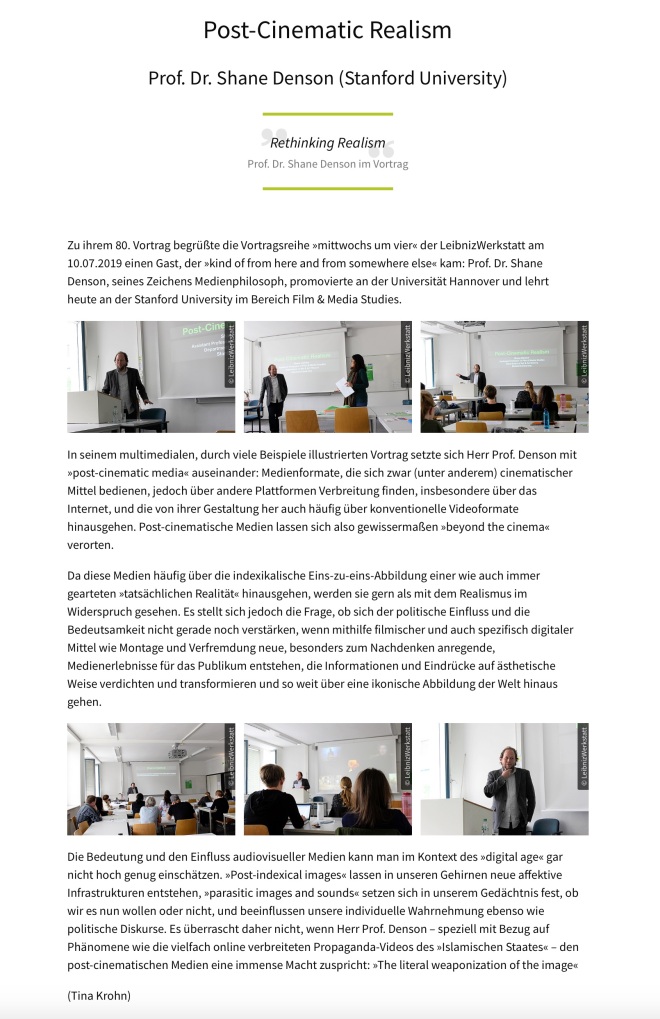
Month: November 2019
Syllabus: Digital and Interactive Media (Winter 2020)

“Declining Russian Media Theory” — Ben Peters at Digital Aesthetic Workshop

Next week, on Thursday, November 21, the Digital Aesthetics Workshop will host Ben Peters for our third workshop of the 2019-2020 season, for a talk entitled “Declining Russian Media Theory.” We’ll meet in the Humanities Center Board Room at 5 PM.
More info:
A first step toward a larger project, Peters test runs ways to decline, in both senses, the problem of Russian media theory. It is a curious fact that nowhere does there exist today, despite the ample intellectual materials, anything that might be called “Russian media theory.” Other scholars have identified various schools of media thought as distinctively German, Canadian, American, French, and British and yet, while the lumber and ruins are ample, no single school of media thought stands today that is recognizably Russian or otherwise discernibly Slavic. Why not? Peters argues not that some kind of Russian media theory should exist (in fact, he offers several reasons why it should not). Rather it is simply to speculate beyond the curious observation that, given the sustained interest in the subject, no distinctively Russian theoretical approach to media has emerged to date. This brief, in turn modest and immodest, and necessarily speculative essay aims not to articulate such a theory, nor to lament its nonexistence, nor even to call for further commentary in that direction. Instead this talk aims to take a step backwards to reflect on the causes of that curious fact, to navigate some obstacles standing in the way of its articulation, to sound out and explore the declensions of such a media theoretic grammar, and to excavate the pre-dispositional grounds of possibility for a Russian—or perhaps Slavic—media theoretic tradition.
Benjamin Peters is a media scholar interested in plumbing uncharted media histories and theories, particularly in the Soviet century. He is also author of How Not to Network a Nation (MIT Press 2016), editor of Digital Keywords (Princeton UP 2016), the Hazel Rogers Associate Professor and Chair of Media Studies at the University of Tulsa, and an affiliated fellow at the Information Society Project at Yale Law School.
LIT+ Conference at Stanford

I am very honored to be speaking alongside some very distinguished thinkers this December at the LIT+ Conference on the State of the Interdisciplines, sponsored by Stanford’s Program in Modern Thought and Literature (MTL), Feminist, Gender, and Sexuality Studies (FemGen), the Stanford Law School, and the Stanford Humanities Center. Watch this space for more info soon!
Jim Campbell’s Discorrelated Images

Last evening I had the pleasure of discussing Jim Campbell’s work with him at the Anderson Collection at Stanford, where he has a wonderful exhibition of LED-based works up right now. It was a far-ranging discussion, in a packed gallery, and great fun all around. Here are my opening remarks:
Before we start our conversation, I have the honor of offering some framing thoughts about Jim Campbell’s work. I want to use this opportunity to put that work into dialogue with some of my own interests and concerns as a theorist of the intersection between computational and moving-image media. I am concerned, in other words, with the historical and phenomenological encounter between the invisible processing of digital information and the visible forms that result from it—and it is precisely this encounter that Jim’s LED-based artworks enact or perform in a variety of thought-provokingly deformative ways. This is to say that his work, by means of occluding, blocking, and de-focusing our view, ironically makes perceptible the very mismatch between perception and computational processing that lies at the heart of digital video as it circulates online, on our smartphones, on DVDs and BluRays, on digital cable and satellite TV, and in the digital projection systems of contemporary movie theaters. In all of those contexts, digital processing remains resolutely invisible to perception (except, that is, through exceptional moments of glitching, buffering, and the like); but, those exceptional and denigrated moments aside, the perceptual “content” of digital video is privileged, thus blinding us to the ways that the medial form of video’s computational processing is changing the very parameters of our embodied perception, or the ways that, as Canadian media theorist Marshall McLuhan put it, our “sensory ratios” are being reformed by our encounter with a new media environment.
By re-valorizing the exceptional, or that which disrupts or impedes the easy transmission of visual “content,” Jim’s work offers an oblique view of the hidden parameters of this new environment; he makes what I call the “discorrelation” between our perception and its infrastructure perceptible—if only in a necessarily incomplete and volatile form. And the volatility of these operations is key: Jim’s works keep our eyes and our bodies moving, making us move now closer and then farther away, causing us to squint and then relax our focus, in order to catch a glimpse of something figural, recognizable, the so-called “content” of the moving images. Certainly, this content is not irrelevant, but it is hardly the ultimate telos or desideratum towards which the work directs our attention. The works are not simple puzzles that are “solved” once we identify their contents. Rather, the incessant oscillation between perception and non-perception, between seeing and not seeing, would seem to be closer to the point, as it is this oscillation that keeps everything at play, unsettling basic categories and forms. We shift our focus between individual LEDs, the screen or wall upon which they reflect, and an indirect, sometimes volumetric illumination of bodies or objects in motion. Our perception doesn’t come to rest upon a stable object or meaning, and this instability infects the broader conceptual context within which our perception is situated: Jim’s work upsets and makes us question so many basic distinctions—for example, between video art and sculpture, between art and engineering, between material substrates and perceptual forms, between perception and imagination. Through his destabilization of perception, he re-opens also the gap between art and technology, a gap created around the time of the industrial revolution, when thinkers like Immanuel Kant helped engineer a split between the aesthetic and the technical, or between the fine arts and the applied arts. Earlier, both the Greek term techne and the Latin ars referred indiscriminately to both arts and technologies. Now, the poets were to work with words while the engineers worked on steam engines; artists concerned themselves with the non-utilitarian forms of aesthetic experience while technologists made the machines that kept the factories running. However, in the space cleared between art and technology, a third thing emerged, a common ground for aesthetic and technological production alike: namely, media in its modern sense. A medium in this sense is not reducible to its “content” in a narrow way; rather, it is something that straddles perceptual form and infrastructure. Take, for example, the way the Sunday comics capitalized on innovations in four-color printing processes, or the way cinema responded to synchronized sound with new genres like the musical or the horror film, which involves its spectator through an offscreen space of screams and bumps in the night. It is in this sense that McLuhan proclaimed that “the medium is the message”—a claim that he explained with the example of the light bulb, a content-less medium, the message of which is the electrification of the world and the resulting transformation of agency, perception, and social relation. In order to explore the message or the meaning of more recent shifts in the media environment, Jim replaces McLuhan’s light bulb with LEDs—the same light emitting diodes that provide backlighting for flatscreen computer monitors and television sets, that power digital projectors, or that illuminate our increasingly “smart” homes. Routing perception through these characteristically digital-era lights, and powering them by way of unseen “custom electronics,” Jim defocuses intentional perception, foregrounds the obfuscation of infrastructure, and indirectly illuminates a media environment in which computation has finally (arguably) rendered the industrial-era split between art and technology untenable.
When I recently spoke to him on the phone, Jim identified himself not as an artist but as an engineer—and certainly he holds the degrees, the patents, and the experience to justify that statement. But he is an engineer of a special sort: an engineer of perception in an age when perception teeters precariously atop invisible circuits and computational infrastructures not cut to our measure, an engineer of experience when experience is routed through ubiquitous circuits of computational processing. Occluding both the image and its digital infrastructure, Jim’s work puts our perceptual experience in motion, incessantly circulating between what we can and cannot see. The work arouses a curiosity about the conditions of this circulation, including the means by which the LEDs, and hence also our perception, have been programmed. In the context of nineteenth-century magic shows and scientific expositions, this curiosity about how the spectacle works has been called an “operational aesthetic”—an aesthetic that, fittingly for the era of industrial media, includes an enjoyment in the sight of technical operation. In the twenty-first-century context of ubiquitous computational processing and experiential engineering, Jim offers us something slightly different, I suggest: an operational aesthetic of perception itself, a questioning of our ability and the means of seeing in an age of discorrelation, when visibility is rendered ambiguously at the margins of human signs and invisible informatic signals.
“The Processual Turn: Images, Logistics, Operations” (SLSA 2019 Panel)
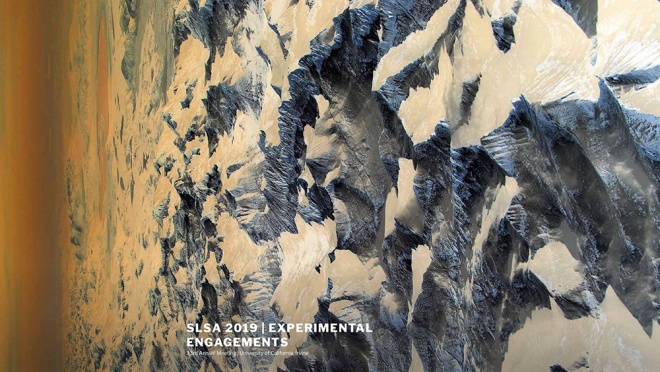
This week I will be heading to Irvine for the Society for Literature, Science, and the Arts (SLSA) 2019 conference, where I’ll be participating in a panel on “The Processual Turn: Images, Logistics, Operations” along with Jason LaRiviere, Matthew Hockenberry, and Yvette Granata. (The panel is at 8am on Saturday, November 9.)
Here are the abstracts:
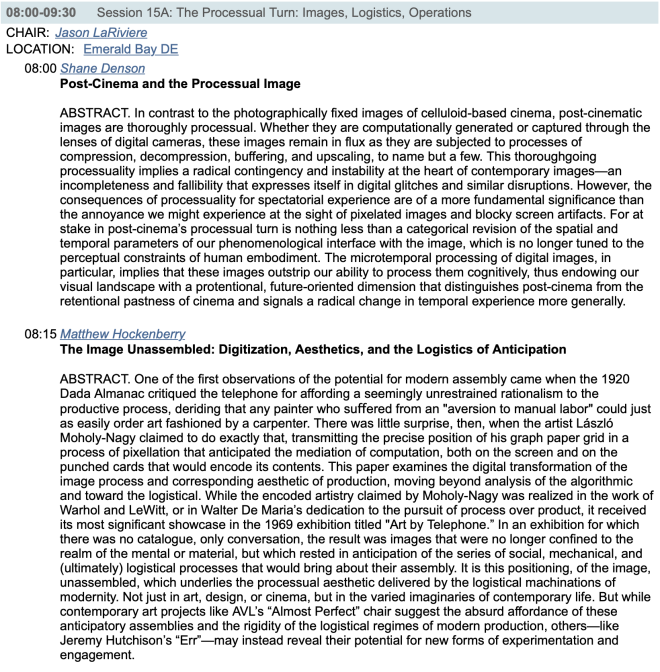
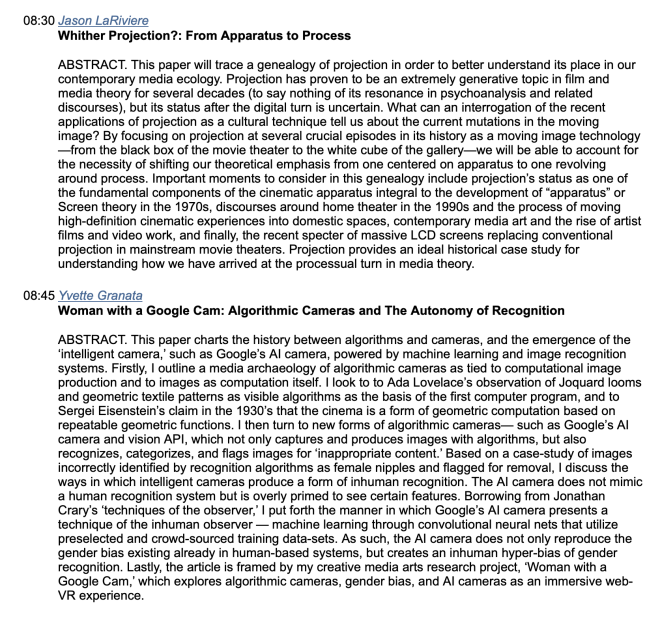
Critical Practices Unit (CPU)
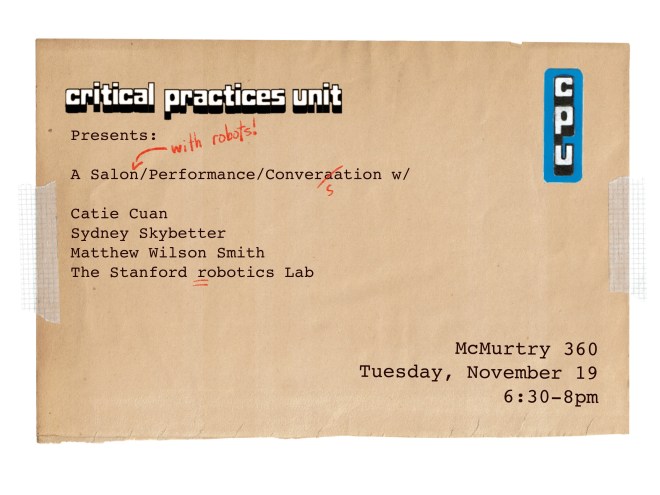
I am excited to announce the inaugural session of Critical Practices Unit (CPU), on November 19 at 6:30pm (in McMurtry 360).
In this interdisciplinary and practice-based group, with support from the Vice President for the Arts, we hope to stage collisions between the various epistemes and critical frameworks we all know and love through performances, art-objects, interactive media, and “critical making” projects, which, in some sense to be explored, materialize critical reflection.
In fidelity to these objects’ disobedience to any specific field, we want to stress that CPU is for those in the humanities, sciences, and arts. These conversations—spanning computation, performance, race, personhood, gesture, interaction, and more—will be made all the richer by a diversity of perspectives.
For our first event, we will be playing with haptic devices for underwater robots graciously loaned by The Stanford Robotics Lab, involving ourselves in a live performance piece / installation by Catie Cuan, and settling into a conversation about the grafting of robotics and performativity. We are overjoyed that situating this discussion will be Sydney Skybetter, Lecturer in Theater and Performance Studies at Brown University, and Matthew Wilson Smith, Professor of German Studies and Performance Studies here at Stanford.
Post-Cinematic Realism
For readers of German, the Leibniz School of Education in Hannover, Germany has a nice write-up of the talk I gave there on “Post-Cinematic Realism” back in July. The material I presented there will also appear in my forthcoming book, Discorrelated Images.
